How To Create a Meaningful Product Vision
Quick steps and easy templates to start crafting your Product Vision.
Have you’ve been in a situation where it’s difficult to determine which product features to pursue or how to prioritize them in your Product Roadmap? Well, that happens when there’s no Product Vision beforehand. Almost like hunting a ghost, isn’t it?
The purpose of a product vision is to provide a clear and compelling future state of a product, including its purpose, value proposition, and long-term goals. This not only guides the team's efforts and decision-making, but also helps to align stakeholders.
First let’s start with understanding the product vision statement. 👇
Understanding the Product Vision Statement
The product vision statement defines the reason for a product's existence, the problems it solves, its target audience, and how it differentiates itself from competitors, and the intended impact.
By familiarizing yourself with the characteristics and components of a product vision statement, you can effectively create a compelling vision for your product. It serves as a framework for the product team to understand their focus and the importance of their work.
Easy Product Vision Statement Format
For [Target customer] who [Opportunity/Problem/Need]. The [Product] is a [Product category] that [Benefit/Reason to buy]. Unlike [Competitive alternative], our product [Primary differentiation].
The Role of a Product Vision in Product Strategy
While a product strategy must adapt to market and customer needs, a product vision remains relatively static to keep the team on track. The product vision acts as the cornerstone of the product strategy.
Characteristics of a Great Product Vision
Purposeful: A purposeful product vision aligns the product with the company's overall strategy and ensures long-term success.
Aspirational: An aspirational product vision energizes the team and encourages bold ideas.
Achievable: While being ambitious, an achievable product vision keeps the team motivated and credible.
Customer-focused: A customer-focused product vision guides decision-making and ensures success in the market.
Concise: A concise vision is easy to remember, communicate, and prevents confusion.
Well-documented: Writing down and sharing the vision ensures it is embedded within the team.
Creating a Meaningful Product Vision
Define the product purpose by answering the questions: Why does your product exist? How will you achieve your why? What is your product?
Outline the product's unique value proposition and how it differentiates itself from competitors.
Identify the target customers and their needs and pain points.
Analyze the competition to identify gaps in the market.
Engage with key stakeholders, including team members, customers, and other relevant parties.
This is an iterative process. It's normal for the vision to evolve and refine over time as you gain more insights and feedback.
Good and Bad Examples
A good product vision is one that effectively communicates the purpose, value, and impact of the product, while a bad product vision lacks clarity, inspiration, or relevance. Here are very simple examples of a good and bad product vision:
Good Product Vision: "To revolutionize transportation by creating an affordable, sustainable, and convenient electric vehicle that accelerates the world's transition to clean energy."
As you can see in the good example, the product vision is clear, inspiring, and future-oriented. It outlines the desired impact (revolutionizing transportation, clean energy transition), the target market (affordable and convenient electric vehicles), and the overarching purpose of the product.
Bad Product Vision: "To make a car that people will like."
While the first example excels on clarity, the bad example is vague, lacks focus, and doesn't provide a clear direction. It doesn't tell the specific value or impact of the product, and it doesn't provide any differentiation or purpose. Also, it provides cero guidance for the development team and fails to resonate with stakeholders or customers.
Wrapping Up
A meaningful product vision sets the direction for your product, inspires your team, and guides decision-making. It should be aligned with your company's overall mission and goals while addressing the specific needs and aspirations of your target audience.
Starting with the format of the product vision statement is a convenient way to answer some of the key questions that should position your product effectively.
How do you craft the Product Vision? What methods do you use? Let me know in the comments!




Great template that includes all the key factors in a compelling product vision - thanks for this!
This is a useful suggestion to kick-start this on product teams.